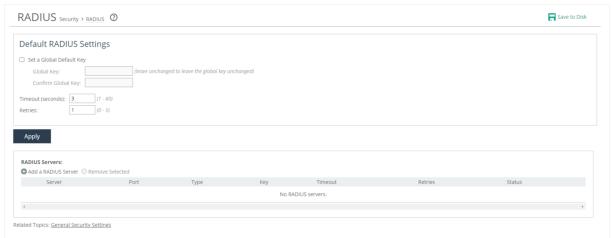Setting RADIUS servers
You set up RADIUS server authentication in the Administration > Security: RADIUS page.
RADIUS is an access control protocol that uses a challenge and response method for authenticating users. Setting up RADIUS server authentication is optional.
You can prioritize local, RADIUS, and TACACS+ authentication methods for the system and set the authorization policy and default user for RADIUS and TACACS+ authorization systems in the Administration > Security: General Security Settings page.
Setting RADIUS server authentication
1. Choose Administration > Security: RADIUS to display the RADIUS page.
RADIUS page

2. Under Default RADIUS Settings, complete the configuration using these controls:
– Set a Global Default Key—Enables a global server key for the RADIUS server.
– Global Key—Specify the global server key.
– Confirm Global Key—Confirm the global server key.
– Timeout—Specify the time-out period in seconds (1 to 60). The default value is 3.
– Retries—Specify the number of times you want to allow the user to retry authentication. The default value is 1.
3. Click Apply to apply your changes to the running configuration.
4. To add a new RADIUS server, complete the configuration using these controls.
If you add a new server to your network and you don’t specify the values described here, the global settings are applied automatically.
– Add a RADIUS Server—Displays the controls for defining a new RADIUS server.
– Hostname or IP Address—Specify the hostname or server IP address.
– Authentication Port—Specify the port for the server.
– Authentication Type—Select one of these authentication types:
PAP—Password Authentication Protocol (PAP), which validates users before allowing them access to the RADIUS server resources. PAP is the most flexible protocol but is less secure than CHAP.
CHAP—Challenge-Handshake Authentication Protocol (CHAP), which provides better security than PAP. CHAP validates the identity of remote clients by periodically verifying the identity of the client using a three-way handshake. This validation happens at the time of establishing the initial link and might happen again at any time. CHAP bases verification on a user password and transmits an MD5 sum of the password from the client to the server.
MS-CHAPv2—The Microsoft version of the Challenge-Handshake Authentication Protocol. MS-CHAPv2 is a more secure authentication protocol than PAP or CHAP.
– Override the Global Default Key—Overrides the global server key for the server.
Server Key—Specify the override server key.
Confirm Server Key—Confirm the override server key.
– Timeout—Specify the time-out period in seconds (1 to 60). The default value is 3.
– Retries—Specify the number of times you want to allow the user to retry authentication. Valid values are from 0 to 5. The default value is 1.
– Enabled—Enables the new server.
– Add—Adds the RADIUS server to the list.
– Remove Selected—Select the check box next to the name and click Remove Selected.
5. Click Save to Disk to save your settings permanently.
To modify RADIUS server settings, click the server IP address in the list of Radius Servers. Use the Status drop-down list to enable or disable a server in the list.
Related topic


